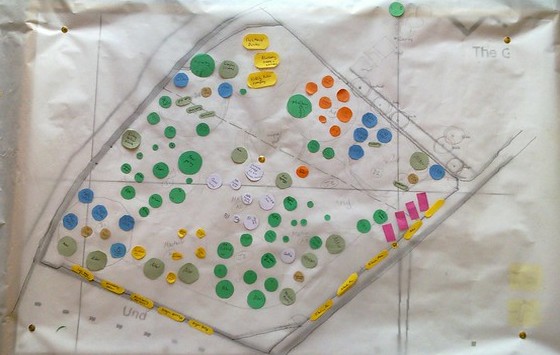Permaculture Design
Principles And Guidelines For Permaculture Garden Designs
The permaculture design principles described here are the guidelines that you follow when you plan your permaculture garden.
(If you are new to this site and haven't read, "What Is Permaculture?", do so first and then return here.)
Ideally a site for a permaculture garden is first analysed in depth. The whole garden, the house and the needs of all people and animals living there are considered and integrated into the design before any work or planting is done.
Permaculture design stems from "protracted and thoughtful observation rather than protracted and thoughtless labour".
If you want to design a small farm or a commercial operation along permaculture principles then this is a crucial step. It should be done by someone who is suitably qualified and experienced.
A permaculture design course is a way to gain that knowledge and experience.
Luckily you don't need a course or a specialist to design a permaculture home garden. Sure, it would be great, but it's not essential.
You don't have to be a landscape designer or a certified permaculturist to use and implement permaculture principles and guidelines in your home garden.
 A fun way to create a permaculture design. Photo: United Diversity
A fun way to create a permaculture design. Photo: United Diversity
Your garden is a great place to experiment with permaculture design and experience its power and effectiveness first hand. I wrote this website to help you and point you in the right direction.
It also doesn't matter if your garden is already established. You can always improve things, one small step or experiment at a time. I'll show you how.
Permaculture Design Principles And Guidelines
Below is a list of the six permaculture design principles that are important when designing a permaculture home garden. Each principle is explained in detail on its own page:
- The Permaculture Zones In A Design
- The Permaculture Principle Of Multiple Functions
- Relative Location In A Permaculture Design
- Permaculture Turns Problems Into Solutions
- Permaculture Designing For Diversity
- Design Scale - Use Of Space
There are more permaculture principles, or maybe I should say more different ways to explain them. Many other principles that you may see mentioned elsewhere follow from the principles that I explained above.
(Some of the above principles already overlap. But hey, some of the things are so important, it doesn't hurt to mention them a few times.)
Also, if you look at the philosophy and ethics of permaculture, other principles become obvious. Many of us who care about the planet already follow those principles in our life.
Conservation, careful energy accounting, reducing waste, using "green" resources, recycling, but also a healthy lifestyle, pure and fresh food, clean water and a clean environment to live in... It's all part of permaculture, either as part of the design or as a result of the design.
I will finish my attempts at explaining permaculture here. The rest of the site is dedicated to specific growing advice, design ideas and tips on how even a little bit of permaculture design and thinking can make a big difference in your garden and your life.
Read about the design principles, starting with: The Permaculture Zones In A Design